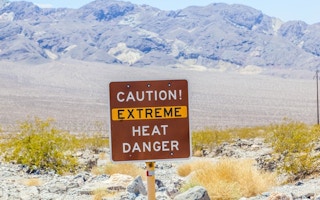According to new data released by the US National Oceanic and Atmospheric Administration (NOAA) Tuesday, globally averaged temperatures over ocean and land surfaces between January and June of 2015 were the hottest on record since 1880.
A statement by the World Meteorological Organisation (WMO) revealed on Jul. 21 that “the average temperature for the six-month period was 0.85°C (1.53°F) above the 20th century average of 15.5°C (59.9°F), surpassing the previous record set in 2010 by 0.09°C (0.16°F).”
Average global sea surface temperatures for the January-June 2015 period outstripped the previous record in 2010 by 0.04°C (0.07°F).
Land surface temperatures also hit record levels, surpassing the previous 2007 high by 0.13°C (0.23°F), according to NOAA’s National Centers for Environmental Information. The average land surface temperature from January to June was +1.40°C (2.52°F).
“Most of the world’s land areas were much warmer than average,” the organisation stated. “These regions include nearly all of Eurasia, South America, Africa, and western North America, with pockets of record warmth across these areas. All of Australia was warmer than average.”
March, May and June of 2015 all broke their monthly temperature records this year; January and February each witnessed the “second warmest” temperatures recorded and April experienced the fourth warmest monthly temperature ever.
NOAA’s Global Analysis for June 2015 further stated, “These six warm months combined with the previous six months (four of which were also record warm) to make the period July 2014–June 2015 the warmest 12-month period in the 136-year period of record, surpassing the previous record set just last month (June 2014–May 2015).”
In an even more disturbing trend, the world’s leading meteorological body stated that the average Arctic sea ice extent for June 2015 was 350,000 square miles (7.7 percent) below the 1981-2010 average and 60,000 square miles larger than the smallest June sea ice extent on record that occurred in 2010.
“This was the third smallest June extent since records began in 1979 according to analysis by the National Snow and Ice Data Center using data from NOAA and NASA,” the WMO release explained.
Meanwhile, the Antarctic sea ice extent in June was 380,000 square miles (7.2. percent) larger than the average for the 1981-2010 period, making it the largest ever Antarctic sea ice extent for the month of June.
Just prior to the release of this new data, on Jul. 1, the WMO together with the World Health Organisaiton (WHO) put out a set of guidelines designed to deal with the health risks associated with hotter global temperatures.
The joint guidance on Heat–Health Warning Systems, released earlier this month, aims to address “health risks posed by heatwaves, which are becoming more frequent and more intense as a result of climate change,” the agencies said.
“Heatwaves are a dangerous natural hazard, and one that requires increased attention,” said Maxx Dilley, Director of WMO’s Climate Prediction and Adaptation Branch, and Maria Neira, Director of WHO’s Department of Public Health, Environmenl and Social Determinants of Health.
“They lack the spectacular and sudden violence of other hazards, such as tropical cyclones or flash floods but the consequences can be severe.”
Over the past 50 years, according to WHO data, hot days, hot nights and heatwaves have become more frequent.
The Intergovernmental Panel on Climate Change (IPCC) noted, “The length, frequency and intensity of heatwaves will likely increase over most land areas during this century.”
Heatwaves also place an increased strain on infrastructure such as power, water and transport.
The agency cited the recent heatwaves in both India and Pakistan that killed thousands of people this summer.
In Pakistan alone, 1,200 perished in the month of June, mostly poor people and manual labourers who were forced to remain in the streets despite government warnings to stay indoors to avoid the blistering 45-degree heat.
According to the WHO, the European heatwaves in the northern hemisphere summer of 2003 were responsible for the deaths of tens of thousands of people, as were the Russian heatwaves, forest fires and associated air pollution in 2010.










